about MINO-WARE
Our company is located in Tajimi, Gifu. Tajimi is well-known as a major MINO-WARE production region, and the ceramics produced in Toki, Tajimi, Mizunami, and Kani in Gifu Prefecture are generally called MINO-WARE. The Tono region, where MINO-WARE is produced and the largest base of pottery production in Japan, produces almost half of all the pottery in Japan, and the ceramics produced here are very diverse in type and in style compared to other pottery producing regions.
about material properties
POTTERY (CERAMICS)
The clay material used for pottery is relatively coarser than those used for porcelain and semi-porcelain wares, so they don't conduct heat well and tend to retain moisture, which results in a uniquely warm appearance and aesthetics. The conbination of clay and glaze as well as the chemical reaction induced by the firing temperature create fine shades of colors and textures. As they are made from natural material, each piece has its own unique look even though they may be under the same product line.
SEMI-PORCELAIN
Semi-porcelain retains the natural texture of pottery while also has porcelain-like qualities. As they are fired at a lower temperature, the colors painted or glazed are well expressed, creating uniquely colorful wares. While the base is well fired and mostly vitrified, they are still slightly water absorbent.
PORCELAIN
Compared to pottery and semi-porcelain wares, porcelain wares are fired at a higher temperature so that the base material is well fired and vitrified, are pure white, and slightly translucent. They are hard and do not absorb water, can be easily washed, and easy to use daily as tableware. There are various types of porcelain, with varying colors and textures, according to the composition of the clay and the firing method.
about product description
-
The size is in mm.
φ(W) : diameter (width) D : depth H(L) : height (length)
- Capacity is full capacity. There are some errors depending on the product. Please use it as a rough guide.
about icons
- microwave safe
- microwave not available
- oven can be used
- oven can not be used
- dishwasher safe
- dishwasher not available
- IH cooking heater can be used
- IH cooking heater not available
- can be cooked on direct fire
- can not be cooked on direct fire
about the color description
| ・RD | red |
| ・DRD | dark red |
| ・LPK | light pink |
| ・PK | pink |
| ・LYE | light yellow |
| ・YE | yellow |
| ・OR | orange |
| ・LGR | light green |
| ・GR | green |
| ・DGR | dark green |
| ・LBL | light blue |
| ・BL | blue |
| ・DBL | dark blue |
| ・NV | navy |
| ・PU | purple |
| ・WH | white |
| ・IV | ivory |
| ・NA | natural |
| ・BE | beige |
| ・CO | cocoa |
| ・BR | brown |
| ・DBR | dark brown |
| ・GY | gray |
| ・BK | black |
| ・GD | gold |
| ・SV | silver |
handling of pottery and porcelain
product characteristics
an explanation of the points that individual differences are likely to occur due to the characteristics, and characteristic products.
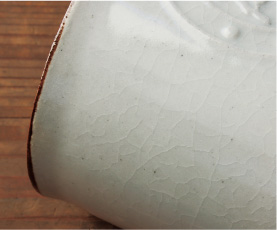

cracks on the glaze of pottery
Fine cracks on the surface (glaze) caused by the difference in shrinkage between the clay and the glaze during firing. These cracks can be visible or invisible, and are a common phenomenon in ceramics. Although there is no problem in using the pottery, the water-absorbing nature of the crazing may cause colored stains such as tea stains. Reference following sentence about pottery, recommend the care before using and after.
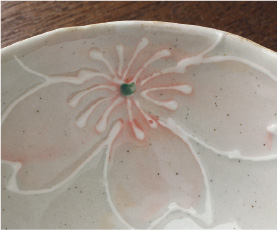

handmade
Handmade products are those whose shapes are molded by hand one by one, or those whose patterns are drawn or colored/glazed by hand by craftsmen. As a result, the size, thickness, shape, and outline of each product may vary. In the case of products that are painted with brushes, the colors and patterns may vary. The warmth of human hands is what makes these products so attractive.
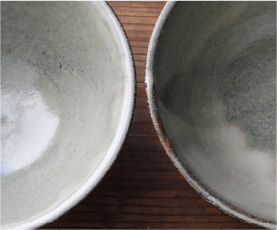

difference in color unevenness and texture
Ceramics are fired in a kiln at a high temperature of around 1,100 to 1,300 degrees Celsius, but the way the fire hits the ceramics is not always consistent. Therefore, even if the same glaze and clay are used, there will be variations in the firing process. The color, luster, and texture of each piece may differ, and burn marks may appear. In addition, since glaze and clay are applied by hand, there is always some unevenness in the application. These varied expressions are one of the unique charms of ceramics.
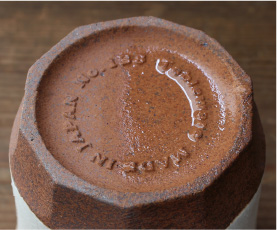

water absorption
Many ceramics absorb water, and if something with a lot of water is left inside for a long period of time, water may leak out, or the food or drink may seep through the crazing and leave a stain or tea stain. Therefore, it is necessary to apply a "sealing treatment." After use, wash the pottery as soon as possible without soaking it, and dry it well before storing.
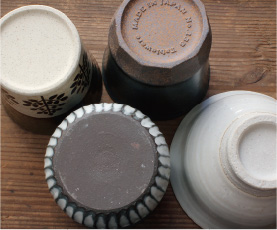
types of pottery clay
In order to increase the texture of the pottery, some products use clay that contains impurities such as iron, or coarse clay that contains a lot of stones. The iron and other components may react and create black spots or glaze color changes. In the case of coarse clay, air bubbles that remain slightly in the clay tend to form pinholes, which are small indentations on the surface. When the surface of the clay is scraped, the small grains of stone in the clay may get rubbed, creating a pattern that looks like lines.
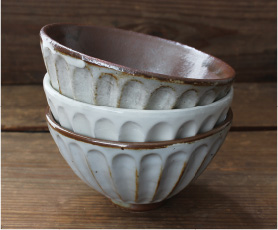
make up with white mud
White clay is applied to the unglazed base, and then transparent glaze is applied and fired. As a result, the surface has minute cracks and crazing. When exposed to water, spots may appear on the surface. Please handle with care, as it absorbs water easily and is prone to stains and spots.
Reference following sentence about pottery, recommend the care before using and after.
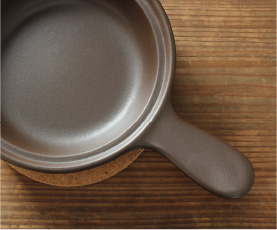
on direct fire available
If pottery is heat-resistant, it is called "heat-resistant pottery." This product is marked as resistant to direct fire. The term "direct fire" refers to the flame of a household gas stove. Please avoid bonfires and charcoal fires as the heat is unstable. This product is not available for use with IH cooking heater. It can be used in ovens, toaster ovens, fish grills, and other ovens with stable temperatures. Due to the nature of heat-resistant pottery, scorch marks and fire soot will stain the pottery as it is used. The surface can be washed clean, but the color cannot be removed once it is stained.
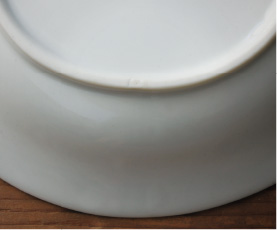
injection casting
The clay is poured into the mold through a pouring hole called "IKOMIGUCHI" in Japanese. The process of pouring mud clay into the mold to form its shape inevitably causes seam lines that may appear as wrinkles or straight lines due to the swelling of the clay near the IKOMIGUCHI opening. We smooth and grind it off by hand, but traces of it always remains. It is often found on the bottom or base stand of the product; please rest assured, this is not damage.
handling note for porcelain, semi-porcelain and ceramics products
●It may be damaged due to sudden temperature changes.
●Please note that it may be damaged by a strong impact or drop.
●Do not use anything that is chipped or cracked as it may cause injury.
●Please dry it well when storing. Leaving it moist may cause mold and odor.
about ceramics (pottery)
●Unlike semi-porcelain and porcelain, pottery is made from relatively coarse clay, which gives it a warm texture and appearance.
However, on the other hand, it is prone to chipping and absorbing water. In order to ensure the longevity of your pottery products, we recommend that you follow the care instructions below.
●Care for pottery (sealing treatment)
Starch will coat the surface and prevent stains from seeping into the pottery.
1. Insert the pottery into a pot filled with starch water (from washing rice or corn or potato starch melted in water) and bring it to a boil on low to medium heat. Let it boil for around 20 minutes on low heat.
2.Let it cool down, then rinse, and allow it to dry naturally.
3.If the crevices are not totally filled after one application, you may try again until they are totally filled.
●Prevent Stains, Odors, and Mold
If you soak the product in clean water before use and let it absorb some of the water, this will reduce the amount of impurities able to penetrate the surface.Pottery products are water absorbent, so if they are left in water for a long time, they may absorb impurities, causing stains, odors, and mold. Please wash the product immediately with detergent and dry well.When storing the container, ensure it is kept sufficiently dry. Insufficient drying may cause an odor or mold growth.
If the product does become stained or smelly, you can remedy this by dissolving baking soda or kitchen bleach in water and soaking the product in it.
●Microwaves and dishwashers cannot be used for pottery products. (Some products are available. Please check the page of each product.)
handling of other materials
glass products
●Microwave, oven and dishwasher cannot be used.
●Please note that it may be damaged by a strong impact or drop.
●Do not use anything that is chipped or cracked as it may cause injury.
●Do not use it with hot drinks. It may be damaged due to sudden temperature changes.
wooden products
●Since it is a natural wood, it may be discolored by light.
●Microwave and dishwasher cannot be used.
●Leaving soaked in water, it will absorb dirt and cause dirt, odor and mold. After use, wash as soon as possible and dry well in a well-ventilated place before storing.
●Since it is a natural wood, it may crack, break, or warp.












